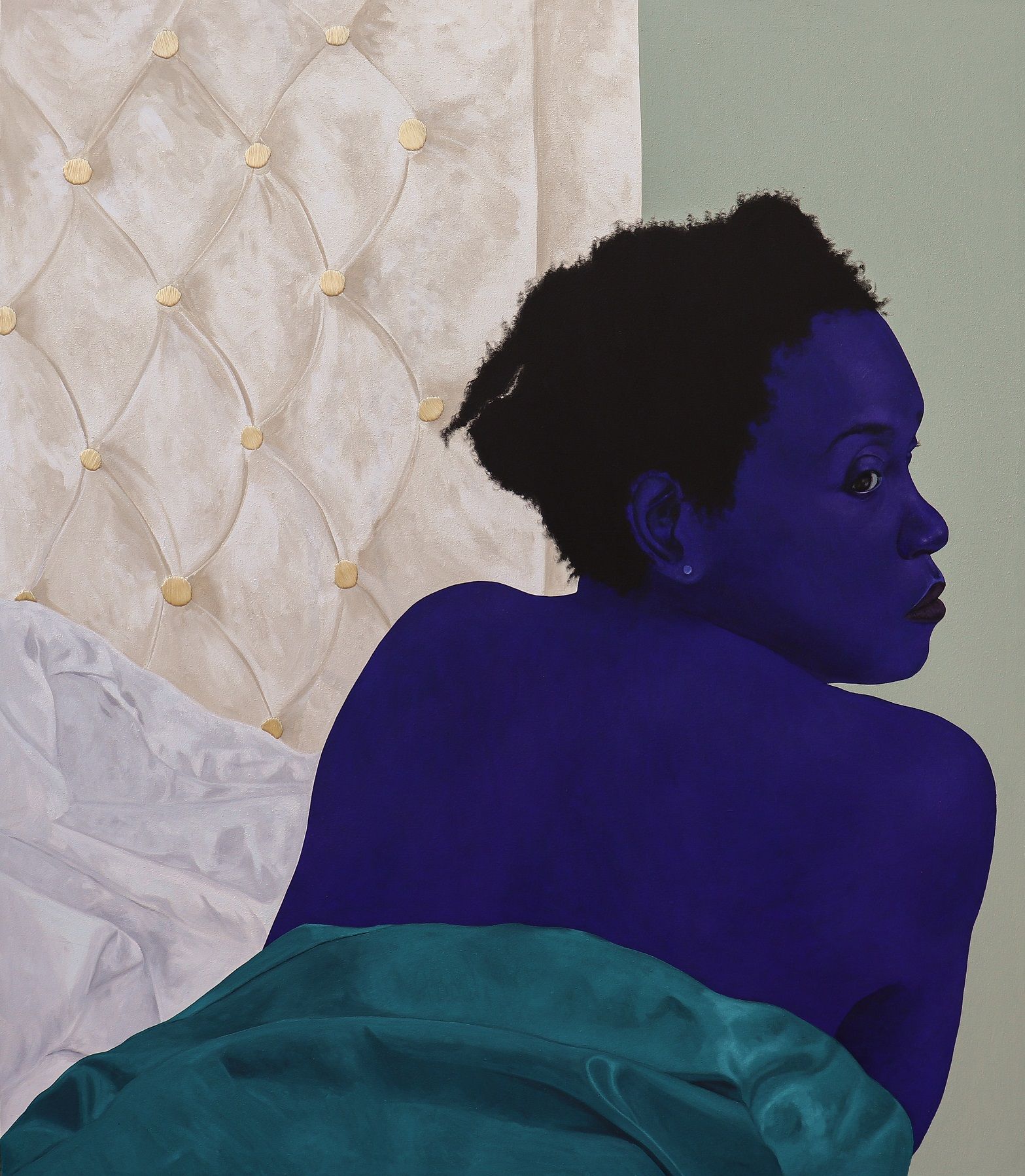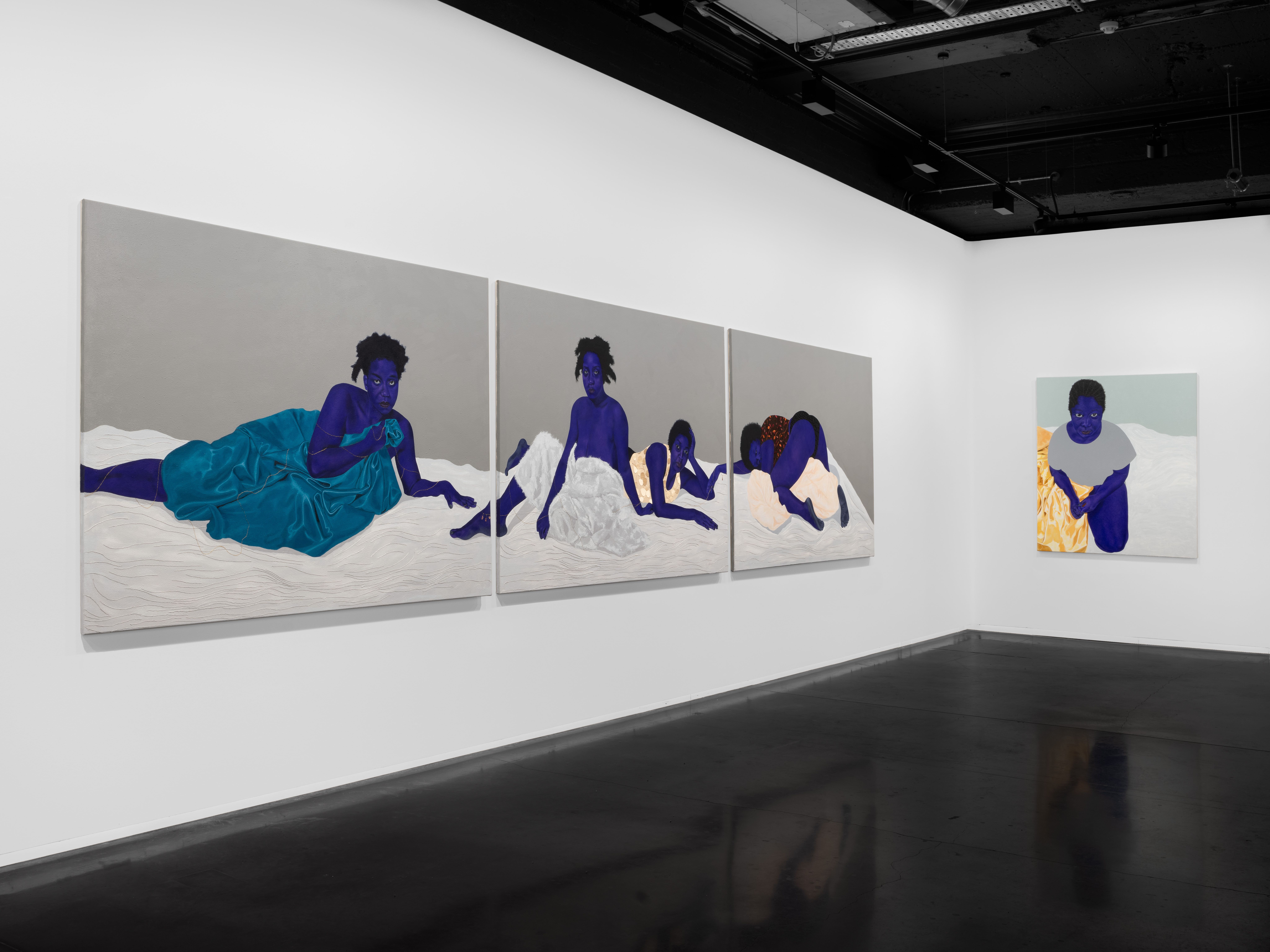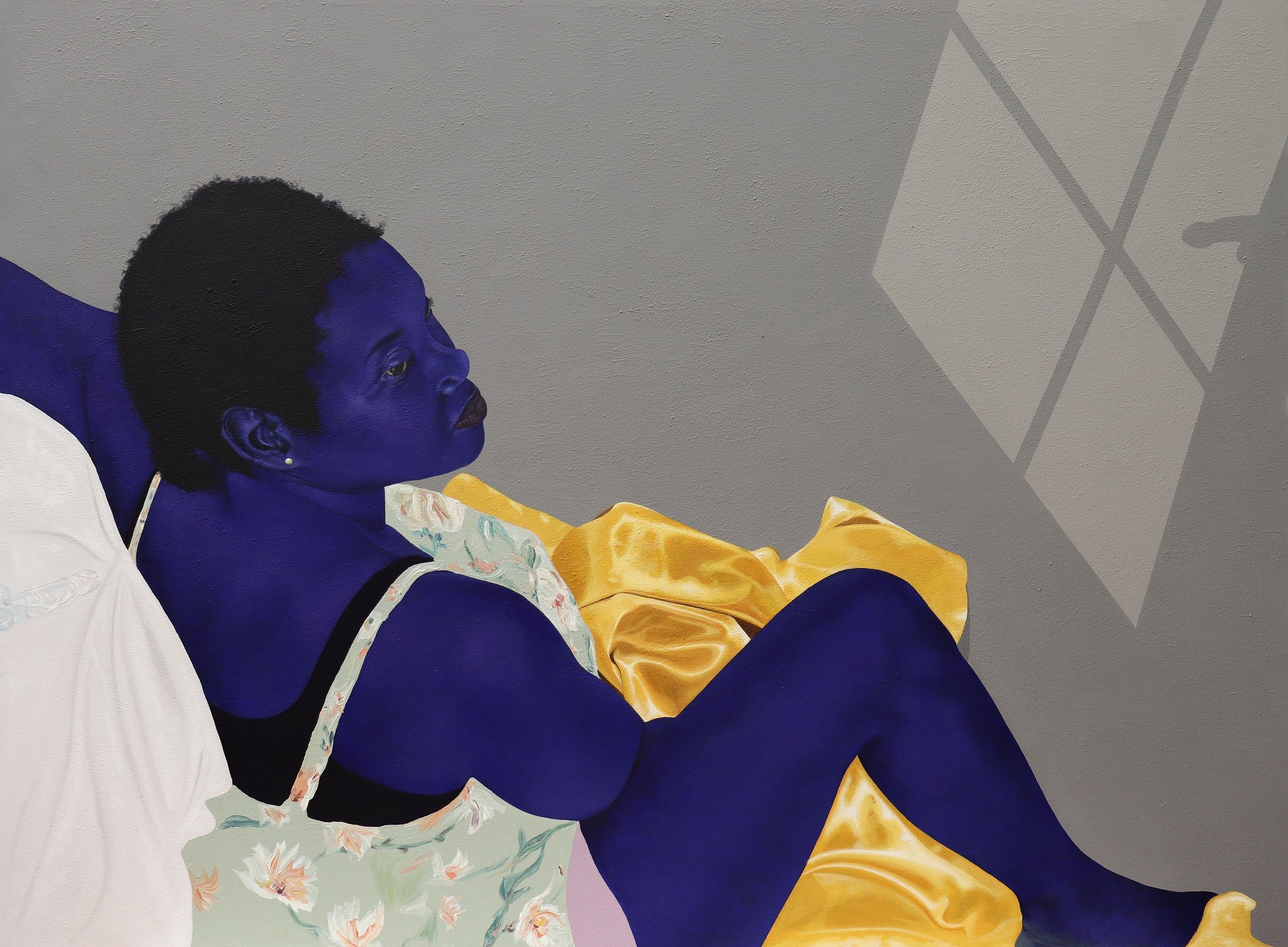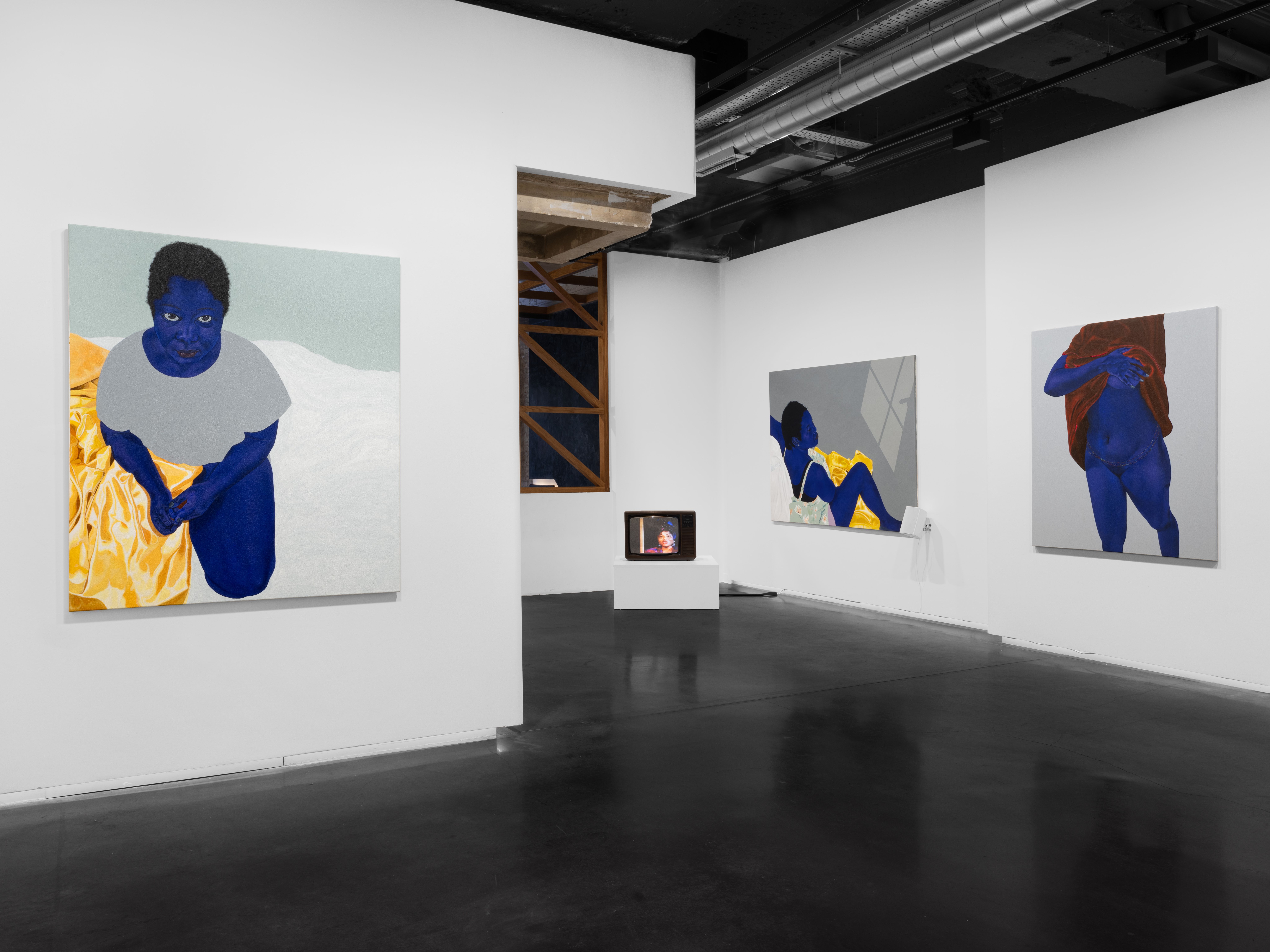
The intimate autobiographical paintings at the heart of Stacey Gillian Abe’s latest exhibition Shrub-let of Old Ayivu explore abstract memory, cultural lineage and shared identity, while confronting conventional depictions of the black body in a history of art framed by the ever-present spectre of colonialism. The intimate autobiographical depictions of indigo-hued women at repose the internationally exhibited Ugandan artist is currently showing at UNIT London are characteristically personal in nature, drawing upon familial ties and cultural history in order to investigate and reshape all-too-easily absorbed narrative tropes around race, class and womanhood – creating a bold panoply of women upon the canvas who are not limited to social, economic, cultural or political constraint. Abe’s use of the colour indigo in her work is pivotal in this regard, given its significance in colonial trade, as is her use of embroidery and chain stitching, an art passed down to her generationally – both of which are employed to create a link between past and present that asserts a new and unapologetic aestheticism in which the black female body is boldly centre stage. The jute shrublet and flowers detailed in various paintings also connect a shared cultural history with the present – jute being a totem for the Ayivu clan, one of the major clans in Arua in the West Nile Region of the artist’s native Uganda. Here, the artist tells Culture Collective why she is drawn to immortalise memories both personal and abstract in her paintings, and explains why she is driven to escape into a world without limits.
Where does the drive to express your inner world via the medium of art come from?
I was a loner growing up and quite introverted, and I found it easier to draw my thoughts and imagine my own world – painting is the only mode of expression that allows me to create a world without limits. The canvas becomes an alternative space for me, a space of imagination and contemplation in which I can be whatever I want to be. It is a space where the rules of the world I am currently in never apply. In a way, it’s a space of escaping this reality and creating my own – in the real world, life is not fair, but in this world, everything goes according to plan. My work is autobiographical in nature and explores my past and continuous experience through memory, and, for me, the female body is the most direct way to materialise memory upon the canvas – the female body goes beyond just being a muse, it is also an extension of myself and those who have come before. I think fragments of people are passed down, and I feel like I have a duty to materialise these fragments from my lineage somehow.
Is the embroidery in the work symbolic of that lineage?
The embroidery is a feminine gesture in the work. It’s a feminine craft traditionally, and my interest in it comes from the shared memories passed down to me from my mother, who also learned her craft from her mother, who learned it from my great grandmother, so, yes, its like a line. That passing down is important to me because I did not always have these people around me growing up, and revisiting my memories through my mother, I realise that there is so much more that I could have learnt from them. It’s important to me immortalise memories in my work, because the older I grow, the less I remember, and I also think about the fact that my mother won’t always be here. I can’t make her stay forever, but I can immortalise our shared memories though this craft.

In a sense, the work is an expression of shared identity ...
It is an expression of a shared identity because when we look at the subjects, we can see that they cease to be myself, but rather are extensions of myself, extensions of my mother; extensions of our lineage. The embroidery is symbolic of the generational connection, and the passing down of memory from the past to the present. The type of stitching I use is called the chain stitch, so, again it’s about the chain and the connection. It’s important to me to archive these memories because what scares me most about death is that when we are gone, we won’t be able to revisit some things – so, for example, when my grandmother died I was very young, and my fear was that I did not spend enough time with her, and did not create enough memories with her when she was were still alive. I think with the world moving faster than it used to, we are often losing that connection with the people around us, and, somehow, we seem to be forgetting that anything can happen, and that these people can disappear any minute.
What would you hope a viewer who is unaware of the concept behind the work would take from exposure to the paintings?
I am very interested in bringing the black body forward – so, without understanding anything about the work, I would like them to focus on the figures, and what it means to have them at the forefront. The work is an opportunity to redefine being black, and an opportunity to rewrite and reposition narratives around the black body. I think about that in many ways. In art history, for example, you have the invisibility of the black body, so this work gives me an opportunity to place it centre-stage – and many years from now this work will become a new archive of the black body. The indigo somehow gives the viewer that gap and space to think about these subjects without boxing them in – they feel black; they look black, but are they black?

What is the significance of indigo in the work?
In the past Indigo was key in the facilitation of the exchange of the black body, so our identification with the colour was one of exchange. The author Catherine McKinley says in her book In Search of Colour that if you had enough indigo in the past you could exchange a black body for it. And, at that time, the clothes with that very precious indigo dye we called blue gold in them were only reserved for the elite. When you look at history, the elite does not associate with the black body, so, it was important for me to re-imagine the black body and rewrite history using this colour. The posers are also generally relaxed, which is also symbolic of defying culture and defying norms, and allowing oneself to open up to new possibilities that do not include being modest. There is a sense of rebellion. The figures are not trying to cover up, and it almost feels as though the viewer is encroaching on their private space or moments. There is a friction, in the sense that this is my private space, and I’m allowing you in but I can only let you in so far.

What is your opinion of the rise of digital art?
I think digital art can rob you of the process. For me, painting is meditative, intimate and time consuming, and within that time-frame wehn painting I am allowed to think and to imagine – to go slowly, and to make mistakes, but also to be human. That human connection is lost to technology, because it makes everything easy. It just feels inauthentic. I am not saying it is completely bad, but when I paint, I want to be in connection with the figures, and I want to have an emotional attachment. I want to feel the skin through brush strokes. I want to feel the textures and see how different colours sit within the textures. You can generate texture with digital painting, of course, but it does not engage your senses fully.
Shrub-let of Old Ayivu exhibits at UNIT London until Jan 27th
Images (top to bottom): See You Later, Again, 2022, Stacey Gillian Abe; Installation shot of Shrub-let of Old Ayivu, 2022 by Eva Hezog; See You Later, 2022, Stacey Gillian Abe; Installation shot of Shrub-let of Old Ayivu, 2022 by Eva Hezog. All images courtesy of the artist and UNIT London.